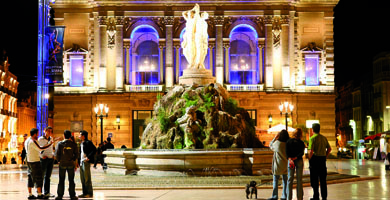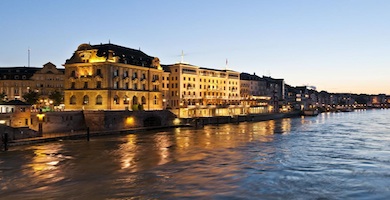APULIA: Exploring History in the Heel of Italy
Michael Webb discovers a rustic retreat and architectural treasury in the hills of Puglia.
Spring comes early to Apulia, a surprisingly fertile and prosperous province in the heel of Italy. The few large cities, from Foggia in the north to Bari and Brindisi down the coast, are best avoided, unless you are taking a ferry across the Adriatic to Croatia or overnight to Greece. Rather, you should do what Norman knights did a thousand years ago: head southwest down the coastal strip while admiring the cathedrals and castles they bequeathed and lingering in towns that seem to have been carved from polished white stone. Monuments that would be overrun with tour buses in Tuscany or even in Sicily are often deserted, making Apulia a wonderful, affordable escape.
For places to eat and stay, consult the English-language version of the Slow Food guide, Osterie & Locande d’Italia. This will introduce you to comfortable inns and family-run trattorias, serving the freshest local fish and vegetables, simply prepared. The roads are uncrowded and the distances short; it’s easy to explore the whole province in a week, and then speed back on the autostrada to catch a train for Rome.
The small town of Trani makes a good first stop. The Romanesque cathedral has been scrubbed and its dazzling white facades are as smooth as a sea-washed pebble. The Normans were pious and many of them voyaged on to fight in the Crusades, but they were in a hurry to put their mark on this earthly paradise. So they built great stone barns that are surprisingly modern in their sheer walls and absence of ornament; the cylindrical chapels at the east end resemble grain silos. The west portico is guarded by an eroded lion and griffin, and a few carved faces peer down from the cornice. In the 12th-century, churches offered sanctuary from attack, so the windows are small and placed high up. That gives the bare interiors a sense of theater as the brilliant sunlight filters down among the massive columns as though through trees in a forest. Still more shadowy is the Byzantine church on the lower level and an early Christian catacomb below that.
The grandest monument of the Norman era is Castel del Monte, a short drive west. An octagonal block with octagonal towers at each corner, it rises from a hill to dominate the countryside. Like the pyramids in Egypt, its massive symmetry has provoked speculation. It’s too remote to be useful as a defensive position and too cramped inside to have served as a hunting lodge. Instead, it may have been constructed as a symbol of authority by Frederick II, the ruler who was called stupor mundi, wonder of the world. For centuries it was a ruin, abandoned and used as a quarry for farm buildings; now it’s been restored and is as crisp as when it was finished in around 1250.
The Norman cathedrals of Ruvo di Puglia and Bitonto are variations on the theme of Trani, and they lead you on to another of Apulia’s special delights: the hill towns of Martina Franca, Ostuni, and Locorotondo. They evoke the white towns of Andalusia and the Greek islands with their arches, steps and alleys that lead into people’s homes. The stone pavers are polished, and splashes of color enliven the white stucco walls. Locorotondo is the smallest and most unspoiled: an intimate stage set from which all but a few local cars have been banished.
Skip Alborobello, which has become a theme park of the conical stone houses called trulli, for there are plenty of examples all around that haven’t been gussied up as souvenir stores. Instead, you should drive on to Lecce, a city that is as exuberant as the Norman settlements were austere. The churches in the historic center—San Croce, San Giovanni Battista, San Matteo and the cathedral—are triumphs of ornament, thanks to the abundance of soft golden sandstone that can be easily carved. Lecce was a prosperous backwater in the Spanish Empire during the baroque era of the 17th and 18th centuries, and nobles competed to flaunt their wealth. It then slipped off the radar screen and is only now attracting the attention it deserves. The center is a traffic-free zone but there’s a lively street scene with lots of good cafes, unpretentious trattorias and a choice of four-star hotels. It’s the perfect place to end your trip or sail off to further adventures.
[simpleflickr set=”72157623845226076″ /]
STAY
Marittima di Diso: Il Convento di Santa Maria di Costantinopoli–This extraordinary bed-and-breakfast, located in a 15th-century convent half an hour south of Lecce, is filled with a collection of museum-quality artifacts and treasures belonging to the ex-treasurer of the British Conservative Party, Lord McAlpine and his wife, who personally look after all their guests. Although you will be socially well-connected, there are no TVs, phones, or newspapers, and definitely no WiFi, but don’t worry… you won’t miss them. Via Convento; + 7736 362328; doubles from $300, including breakfast, lunch, wine, and laundry service.
Fasano: Masseria Marzalossa–A restored 17th-century stone farmhouse offers timeless tranquility and good local cuisine. C. da Pezze Vicine 65; +39.080.4413024; email: masseriamarzalossa@marzalossa.com. Click here for current specials.
Lecce: Patria Palace–A Starwood Hotel located in a period-style palace on a pedestrian square within the old city. Piazzetta Riccardi; + 39 0832 245111; email: info@patriapalacelecce.com
Martina Franca: Il Gallo Felice–A modest B&B in a trio of trulli with a pretty garden and a friendly owner, a mile out of the city. Via Crispiano; + 335 824 8622
Monopoli: Il Melograno–If you are seeking a tranquil retreat, stay in this idyllic 16th-century farmhouse surrounded by fruit trees, which boasts modern comforts and ageless charm, as well as its own beach. The large new Orlane SPA is equipped with state of the art features like the hammam with rassoul, the Evian douche and gym. C. da Torricella 345; + 080 690 9030
EAT
Ceglie Messapica: Cibus–Locavores and Slow Food aficionados will love the rare treats on the menu and the wine list; a standout in a small town that’s proud of its gastronomic traditions. Via Chianche di Scarano 7; + 0831 388980
Cisternino: Taverna della Torre–A rustic trattoria at the center of this labyrinthine white town, where you can enjoy the best offerings of sea and farm. Via San Quirico 3; + 080 444 9264
Lecce: Cucina Casareccia–Anna Carmela Perrone, the friendly owner of this trattoria, will guide you through the menu of local specialties. Via Colonnello Archimede Costadura 19; + 083 224 5178
Martina Franca: Il Ritrovo degli Amici–Anna Ancona prepares delicious, multi-course dinners, and offers a good selection of gutsy local reds. Corso Messapia 8; + 080 483 9249
Montegrosso: Antiche Sapori–A simple trattoria in a rustic setting offering fresh authentic local cuisine. Be sure to reserve. Piazza San Isidoro 9; +0883 569529; email: info@antichisapori.biz
Ruvo di Puglia: UPEPPIDE–An atmospheric, stone-vaulted osteria serving the best local cuisine. Vico Sant’Agnese 2; + 080 361 3879; email: info@upepidde.it
Michael Webb
around the world.
Latest posts by Michael Webb
- DESTINATION: Revisiting the South of France - April 30, 2024
- Exploring the Czech Republic - January 29, 2024
- Rediscovering Morocco - April 6, 2022





